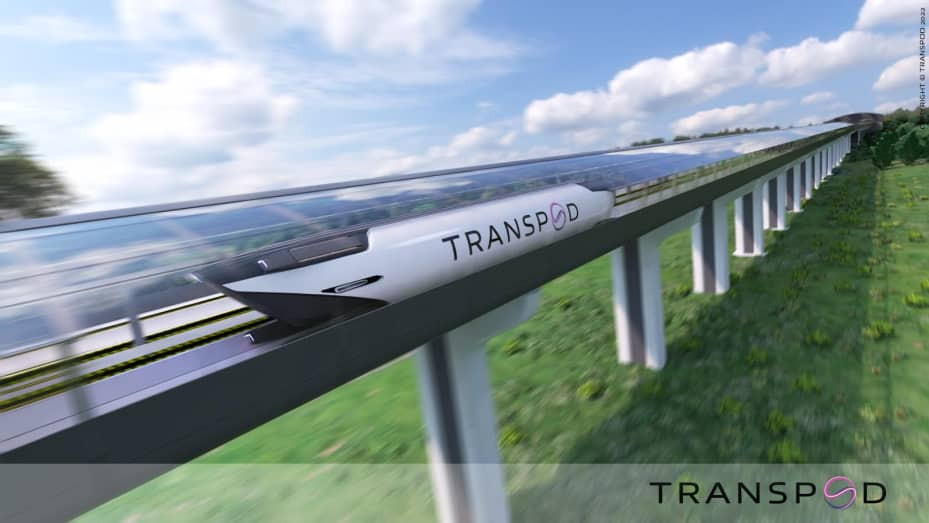Super-speed train hybrid aircraft running 1000 km/h, cheaper than air tickets is expected to create a big explosion for green traffic
- Tram Ho
TransPod is the world’s leading start-up building the world’s leading ultra-high-speed ground transportation system (TransPod Line). The Toronto, Canada-based company recently announced plans for “FluxJet,” an all-electric vehicle that is “a combination of plane and train.” The project is currently in the concept stage with a 24.9m long maglev train, carrying passengers with a speed of about 997.79 km/h.
This is faster than commercial aircraft and almost three times the speed of most current bullet trains. Because it runs on electricity, FluxJet has zero carbon emissions. The company says the FluxJet train will rely on “contactless power transmission” technology, which draws power from the existing grid through a magnetic field. The aerodynamic design of the aircraft tug can help reduce friction when traveling.
FluxJet trains will operate on the TransPod Line, a transportation system with stations in key locations and major cities. The company confidently asserts that this will be the transportation network that will redefine the movement of goods and passengers and change the way people live and travel.
In July, the TransPod company released a video showing the FluxJet design process, including an overview of how the technology works and animations showing what the final version will look like.
TransPod says the cost of passengers traveling by FluxJet will be 44% cheaper than buying air tickets. In the first phase of the project, the company plans to build a nearly 321.8 km/h network of vacuum paths between the Canadian cities of Edmonton and Calgary.
According to this plan, a train will depart every 2 minutes to meet the travel needs of the people. The vessel will carry up to 54 passengers and 10 tons of cargo per trip. The company says the 281.6-kilometer trip between the two cities will take just 45 minutes.

Photo: TransPod
A commitment worth $18 billion
That is good information. But the bad news is that even with optimism, this transit system will still take years to build and cost billions of dollars.
In March, TransPod raised $550 million in funding from UK investors Broughton Capital Group and Chinese state-owned China-East Resources Import & Export. That money funds ongoing research and development, along with plans to build a test track and conduct speed tests between 2023 and 2027.
The company says it wants to begin construction on its intercity FluxJet service by 2027. TransPod also says the project will ultimately cost $18 billion. That means they will need to raise a lot more money going forward, whether from private investors, government funding or both.

Photo: TransPod
Overcoming billionaires Elon Musk and Richard Branson, a Canadian company wants to join the race to create the most optimal means of transportation.
TransPod claims the expense will be well worth it. The company predicts that building the FluxJet system will create “up to 140,000 jobs” and add $19.2 billion to the region’s gross domestic product (GDP). TransPod says the system will reduce carbon dioxide emissions by 636,000 tons per year upon completion of construction.
At the launch of FluxJet, TransPod co-founder and CEO Sebastien Gendron said: “All the hard work of the past few years has led to this important moment, when conversations are becoming reality. real”.
“This milestone is a huge step forward,” said Ryan Janzen, Co-Founder and CTO of TransPod. FluxJet is a combination of scientific research, industrial development and massive infrastructure to address passenger needs and reduce our reliance on jet aircraft and fuel-efficient highways. fossil material”.
Yung Wu, CEO of MaRS Discovery District, commented: “TransPod completely changes the game in transporting passengers and freight at extremely high speed, with zero emissions, between major cities.
“It is time for our policymakers, investors and operators to take bold action to support the commercialization of Canadian initiatives like TransPod, to win the global innovation economy.” trillions of dollars worth of demand”.
Billionaires’ bullet train projects
Meanwhile, billionaire Richard Branson’s Virgin Hyperloop One company previously announced plans for a similar super-speed train system. The aim is to transport passengers at speeds up to 1223 km/h.
In tests, Virgin’s prototypes have so far reached speeds of about 386 km/h. The company recently laid off 111 employees and focused on shipping goods instead of people.
Similarly, billionaire Elon Musk’s The Boring Company has been digging underground tunnels in Los Angeles and Las Vegas for years now in the hope of eventually filling them with a high-speed “hyperloop” transportation system. high. The electromagnetic induction train will carry groups of passengers at a speed of over 965 km/h.
Until now, the tunnels have only been used to transport Tesla cars, at speeds of about 80 km/h. Mr Musk posted on Twitter in April that he wanted to begin “full-scale testing” of an electromagnetically-induced supersonic train by the end of the year.
According to CNBC, Transpod
Source : Genk
